2016 FORD FOCUS ELECTRIC maintenance
[x] Cancel search: maintenancePage 4 of 276
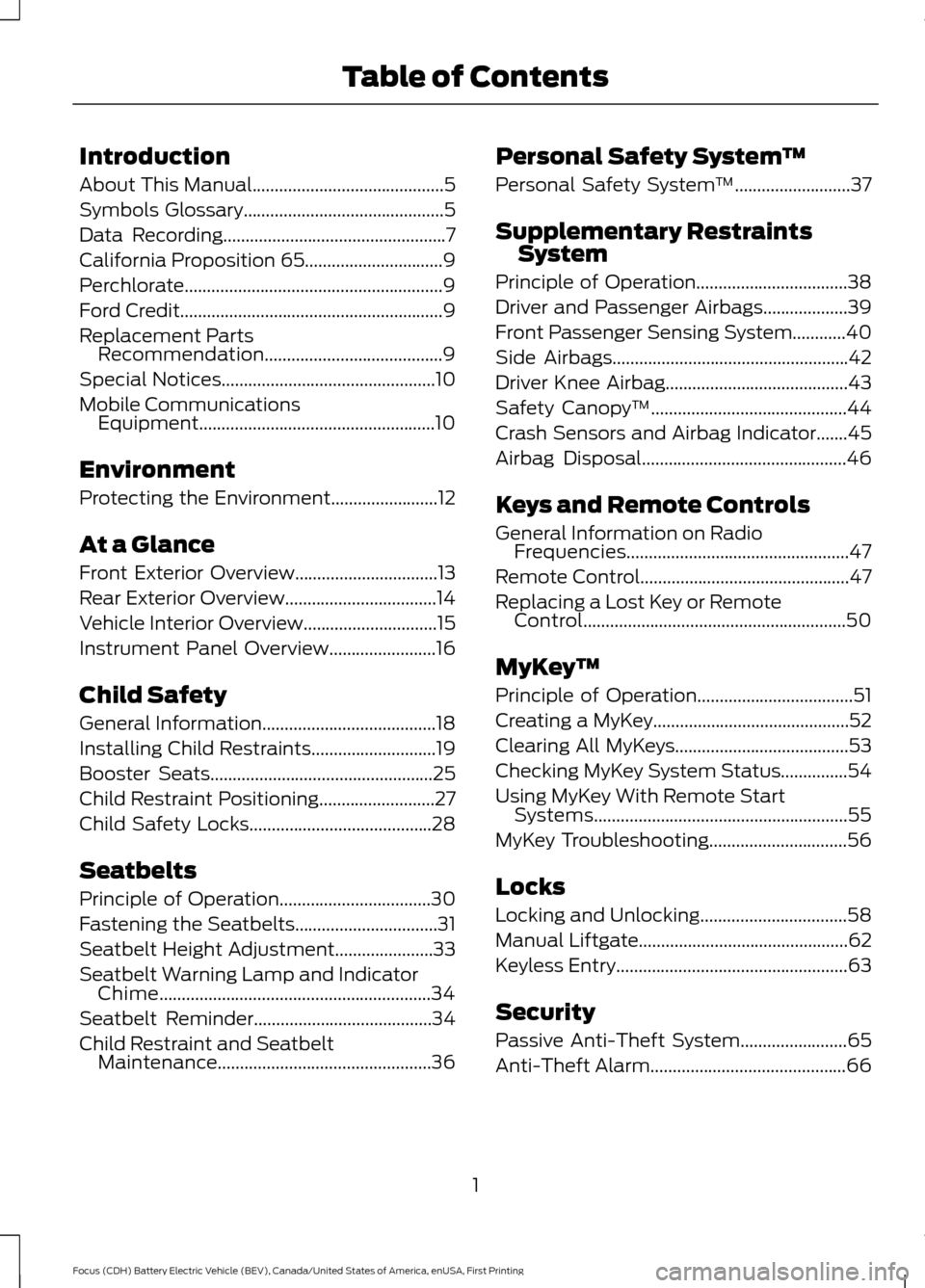
Introduction
About This Manual...........................................5
Symbols Glossary.............................................5
Data Recording..................................................7
California Proposition 65...............................9
Perchlorate..........................................................9
Ford Credit
...........................................................9
Replacement Parts Recommendation........................................9
Special Notices
................................................10
Mobile Communications Equipment.....................................................10
Environment
Protecting the Environment
........................12
At a Glance
Front Exterior Overview
................................13
Rear Exterior Overview..................................14
Vehicle Interior Overview..............................15
Instrument Panel Overview........................16
Child Safety
General Information
.......................................18
Installing Child Restraints
............................19
Booster Seats..................................................25
Child Restraint Positioning
..........................27
Child Safety Locks.........................................28
Seatbelts
Principle of Operation
..................................30
Fastening the Seatbelts
................................31
Seatbelt Height Adjustment
......................33
Seatbelt Warning Lamp and Indicator Chime.............................................................34
Seatbelt Reminder
........................................34
Child Restraint and Seatbelt Maintenance................................................36 Personal Safety System
™
Personal Safety System ™
..........................37
Supplementary Restraints System
Principle of Operation..................................38
Driver and Passenger Airbags...................39
Front Passenger Sensing System............40
Side Airbags.....................................................42
Driver Knee Airbag.........................................43
Safety Canopy ™
............................................44
Crash Sensors and Airbag Indicator.......45
Airbag Disposal
..............................................46
Keys and Remote Controls
General Information on Radio Frequencies..................................................47
Remote Control
...............................................47
Replacing a Lost Key or Remote Control...........................................................50
MyKey ™
Principle of Operation
...................................51
Creating a MyKey............................................52
Clearing All MyKeys.......................................53
Checking MyKey System Status...............54
Using MyKey With Remote Start Systems.........................................................55
MyKey Troubleshooting...............................56
Locks
Locking and Unlocking
.................................58
Manual Liftgate
...............................................62
Keyless Entry
....................................................63
Security
Passive Anti-Theft System
........................65
Anti-Theft Alarm............................................66
1
Focus (CDH) Battery Electric Vehicle (BEV), Canada/United States of America, enUSA, First Printing Table of Contents
Page 6 of 276
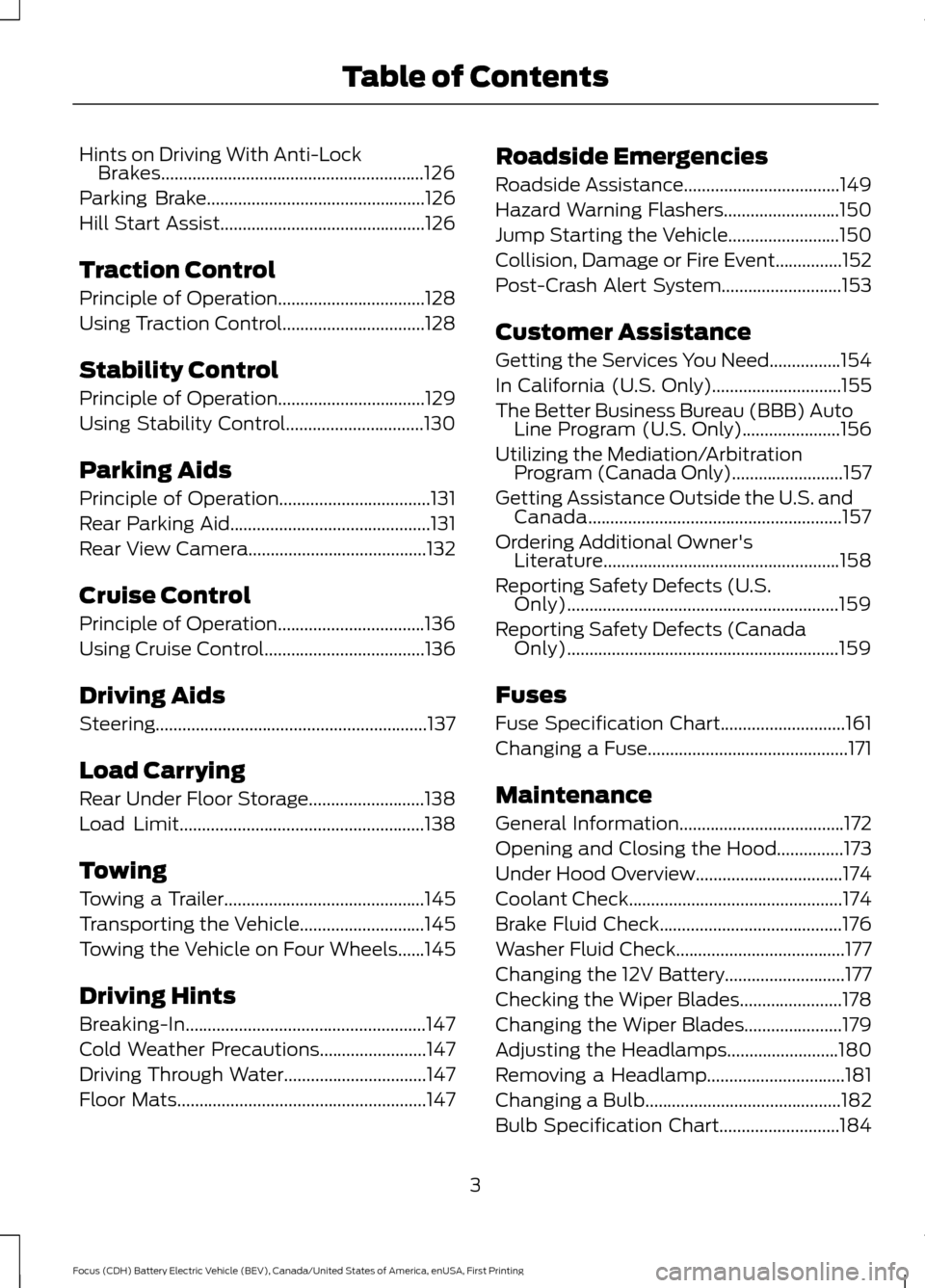
Hints on Driving With Anti-Lock
Brakes...........................................................126
Parking Brake.................................................126
Hill Start Assist..............................................126
Traction Control
Principle of Operation.................................128
Using Traction Control................................128
Stability Control
Principle of Operation.................................129
Using Stability Control...............................130
Parking Aids
Principle of Operation..................................131
Rear Parking Aid.............................................131
Rear View Camera........................................132
Cruise Control
Principle of Operation.................................136
Using Cruise Control
....................................136
Driving Aids
Steering
.............................................................137
Load Carrying
Rear Under Floor Storage..........................138
Load Limit
.......................................................138
Towing
Towing a Trailer
.............................................145
Transporting the Vehicle............................145
Towing the Vehicle on Four Wheels
......145
Driving Hints
Breaking-In......................................................147
Cold Weather Precautions........................147
Driving Through Water................................147
Floor Mats........................................................147 Roadside Emergencies
Roadside Assistance
...................................149
Hazard Warning Flashers..........................150
Jump Starting the Vehicle.........................150
Collision, Damage or Fire Event...............152
Post-Crash Alert System...........................153
Customer Assistance
Getting the Services You Need................154
In California (U.S. Only).............................155
The Better Business Bureau (BBB) Auto Line Program (U.S. Only)......................156
Utilizing the Mediation/Arbitration Program (Canada Only).........................157
Getting Assistance Outside the U.S. and Canada.........................................................157
Ordering Additional Owner's Literature
.....................................................158
Reporting Safety Defects (U.S. Only).............................................................159
Reporting Safety Defects (Canada Only).............................................................159
Fuses
Fuse Specification Chart
............................161
Changing a Fuse.............................................171
Maintenance
General Information.....................................172
Opening and Closing the Hood...............173
Under Hood Overview.................................174
Coolant Check................................................174
Brake Fluid Check.........................................176
Washer Fluid Check......................................177
Changing the 12V Battery...........................177
Checking the Wiper Blades
.......................178
Changing the Wiper Blades......................179
Adjusting the Headlamps.........................180
Removing a Headlamp...............................181
Changing a Bulb
............................................182
Bulb Specification Chart...........................184
3
Focus (CDH) Battery Electric Vehicle (BEV), Canada/United States of America, enUSA, First Printing Table of Contents
Page 7 of 276
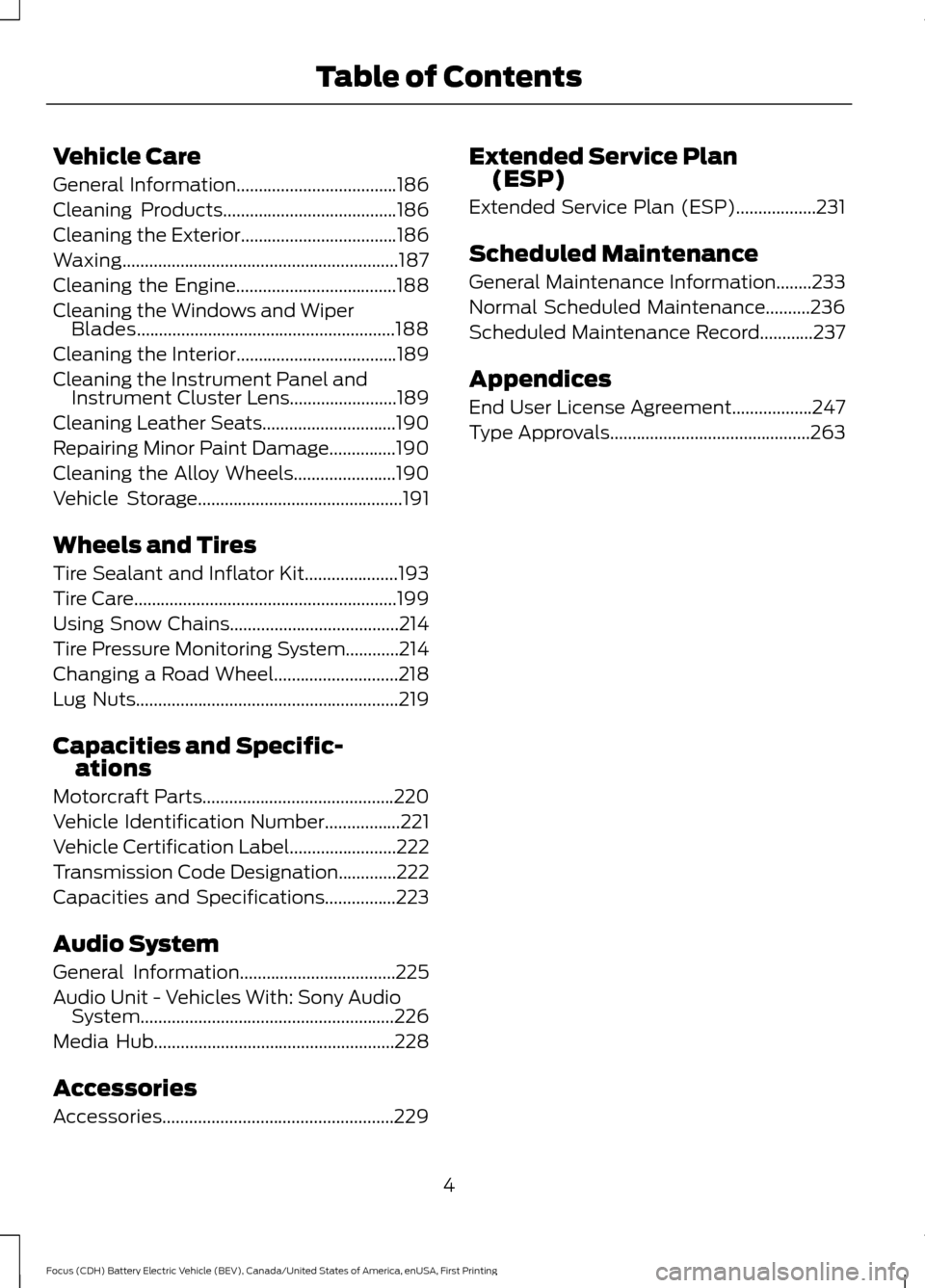
Vehicle Care
General Information....................................186
Cleaning Products
.......................................186
Cleaning the Exterior
...................................186
Waxing
..............................................................187
Cleaning the Engine....................................188
Cleaning the Windows and Wiper Blades..........................................................188
Cleaning the Interior
....................................189
Cleaning the Instrument Panel and Instrument Cluster Lens
........................189
Cleaning Leather Seats
..............................190
Repairing Minor Paint Damage...............190
Cleaning the Alloy Wheels
.......................190
Vehicle Storage
..............................................191
Wheels and Tires
Tire Sealant and Inflator Kit.....................193
Tire Care
...........................................................199
Using Snow Chains
......................................214
Tire Pressure Monitoring System............214
Changing a Road Wheel............................218
Lug Nuts
...........................................................219
Capacities and Specific- ations
Motorcraft Parts
...........................................220
Vehicle Identification Number
.................221
Vehicle Certification Label........................222
Transmission Code Designation.............222
Capacities and Specifications................223
Audio System
General Information...................................225
Audio Unit - Vehicles With: Sony Audio System.........................................................226
Media Hub
......................................................228
Accessories
Accessories....................................................229 Extended Service Plan
(ESP)
Extended Service Plan (ESP)
..................231
Scheduled Maintenance
General Maintenance Information
........233
Normal Scheduled Maintenance..........236
Scheduled Maintenance Record
............237
Appendices
End User License Agreement..................247
Type Approvals
.............................................263
4
Focus (CDH) Battery Electric Vehicle (BEV), Canada/United States of America, enUSA, First Printing Table of Contents
Page 12 of 276
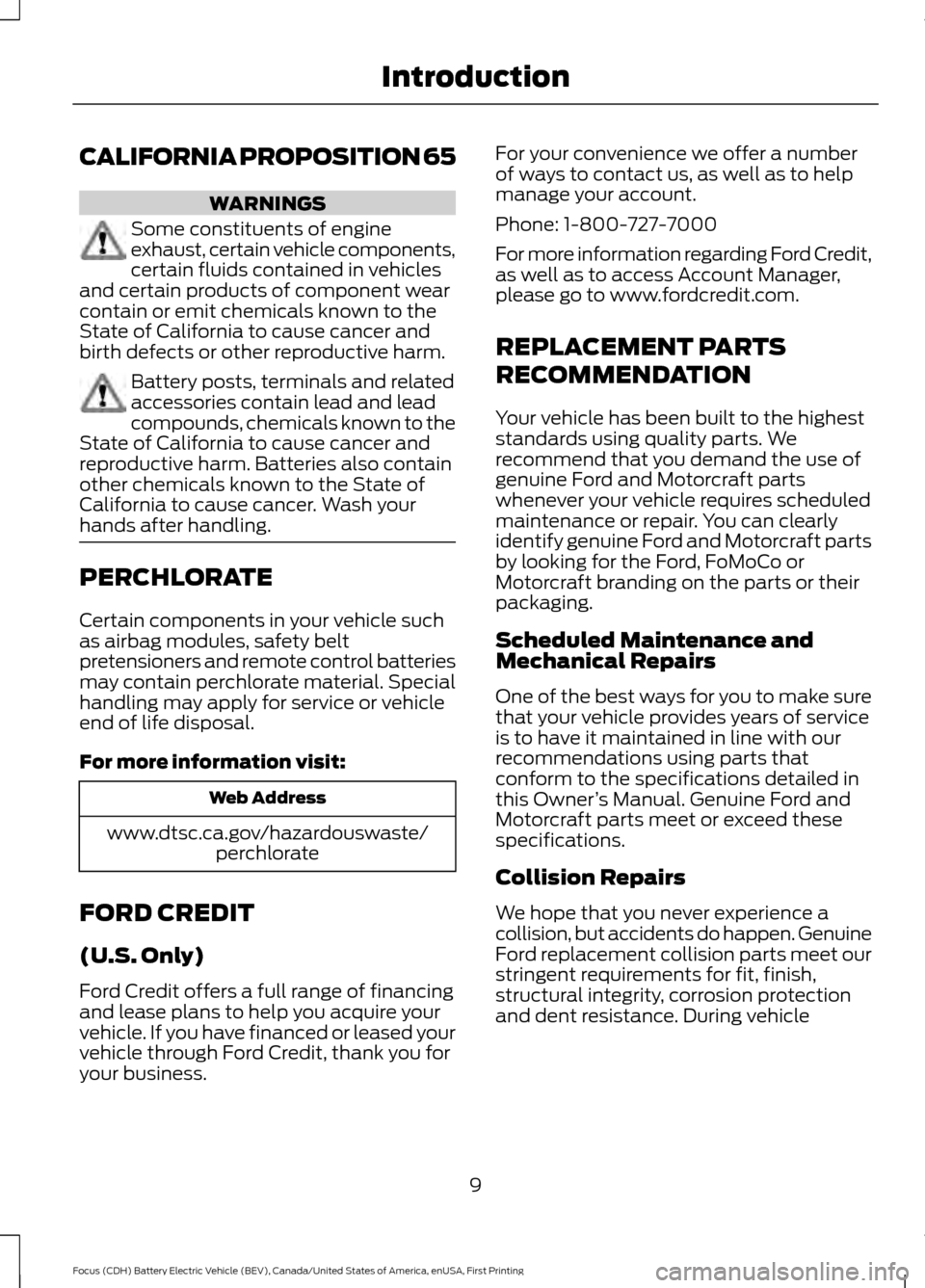
CALIFORNIA PROPOSITION 65
WARNINGS
Some constituents of engine
exhaust, certain vehicle components,
certain fluids contained in vehicles
and certain products of component wear
contain or emit chemicals known to the
State of California to cause cancer and
birth defects or other reproductive harm. Battery posts, terminals and related
accessories contain lead and lead
compounds, chemicals known to the
State of California to cause cancer and
reproductive harm. Batteries also contain
other chemicals known to the State of
California to cause cancer. Wash your
hands after handling. PERCHLORATE
Certain components in your vehicle such
as airbag modules, safety belt
pretensioners and remote control batteries
may contain perchlorate material. Special
handling may apply for service or vehicle
end of life disposal.
For more information visit:
Web Address
www.dtsc.ca.gov/hazardouswaste/ perchlorate
FORD CREDIT
(U.S. Only)
Ford Credit offers a full range of financing
and lease plans to help you acquire your
vehicle. If you have financed or leased your
vehicle through Ford Credit, thank you for
your business. For your convenience we offer a number
of ways to contact us, as well as to help
manage your account.
Phone: 1-800-727-7000
For more information regarding Ford Credit,
as well as to access Account Manager,
please go to www.fordcredit.com.
REPLACEMENT PARTS
RECOMMENDATION
Your vehicle has been built to the highest
standards using quality parts. We
recommend that you demand the use of
genuine Ford and Motorcraft parts
whenever your vehicle requires scheduled
maintenance or repair. You can clearly
identify genuine Ford and Motorcraft parts
by looking for the Ford, FoMoCo or
Motorcraft branding on the parts or their
packaging.
Scheduled Maintenance and
Mechanical Repairs
One of the best ways for you to make sure
that your vehicle provides years of service
is to have it maintained in line with our
recommendations using parts that
conform to the specifications detailed in
this Owner
’s Manual. Genuine Ford and
Motorcraft parts meet or exceed these
specifications.
Collision Repairs
We hope that you never experience a
collision, but accidents do happen. Genuine
Ford replacement collision parts meet our
stringent requirements for fit, finish,
structural integrity, corrosion protection
and dent resistance. During vehicle
9
Focus (CDH) Battery Electric Vehicle (BEV), Canada/United States of America, enUSA, First Printing Introduction
Page 16 of 276
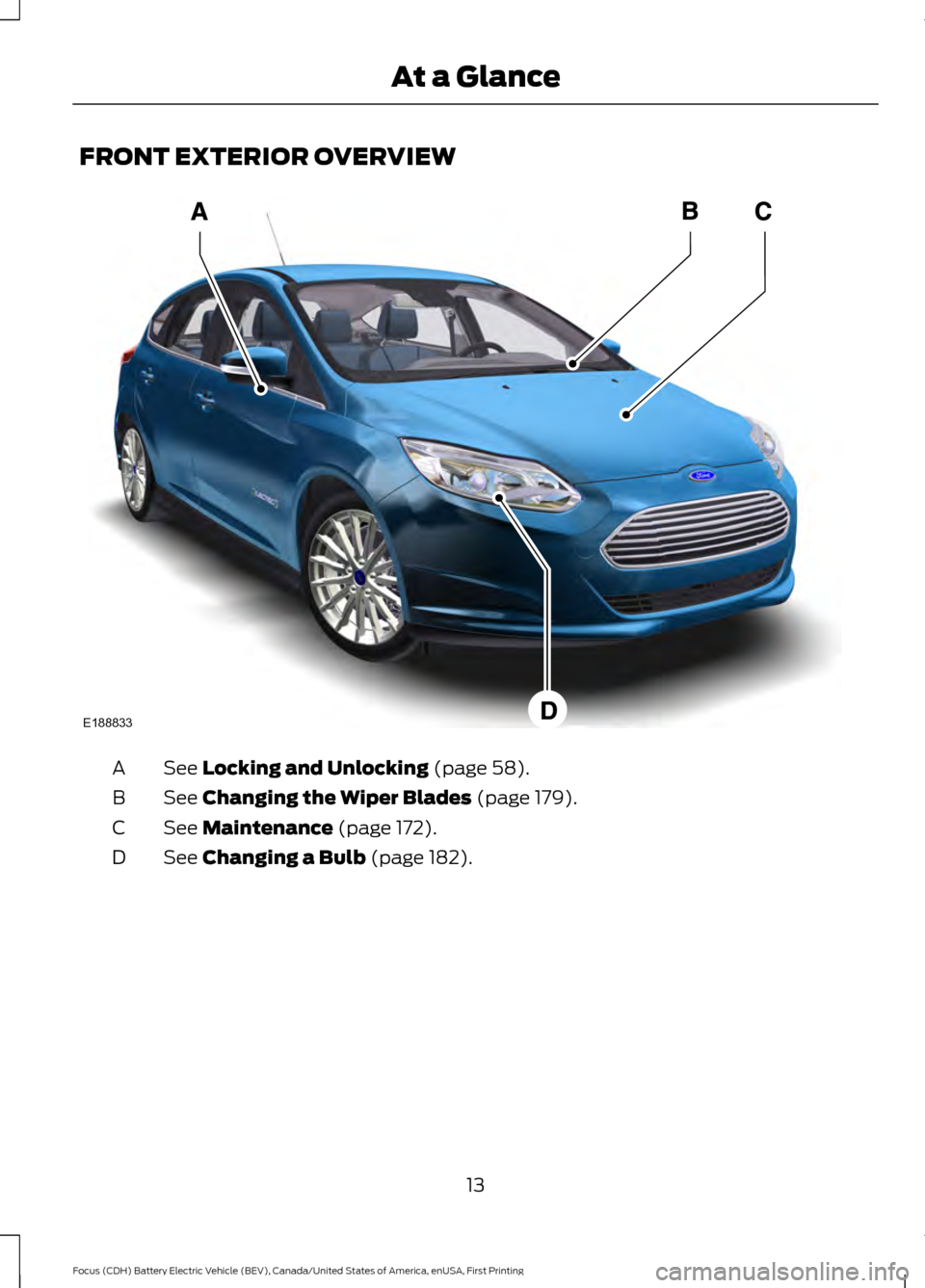
FRONT EXTERIOR OVERVIEW
See Locking and Unlocking (page 58).
A
See
Changing the Wiper Blades (page 179).
B
See
Maintenance (page 172).
C
See
Changing a Bulb (page 182).
D
13
Focus (CDH) Battery Electric Vehicle (BEV), Canada/United States of America, enUSA, First Printing At a GlanceE188833
Page 39 of 276
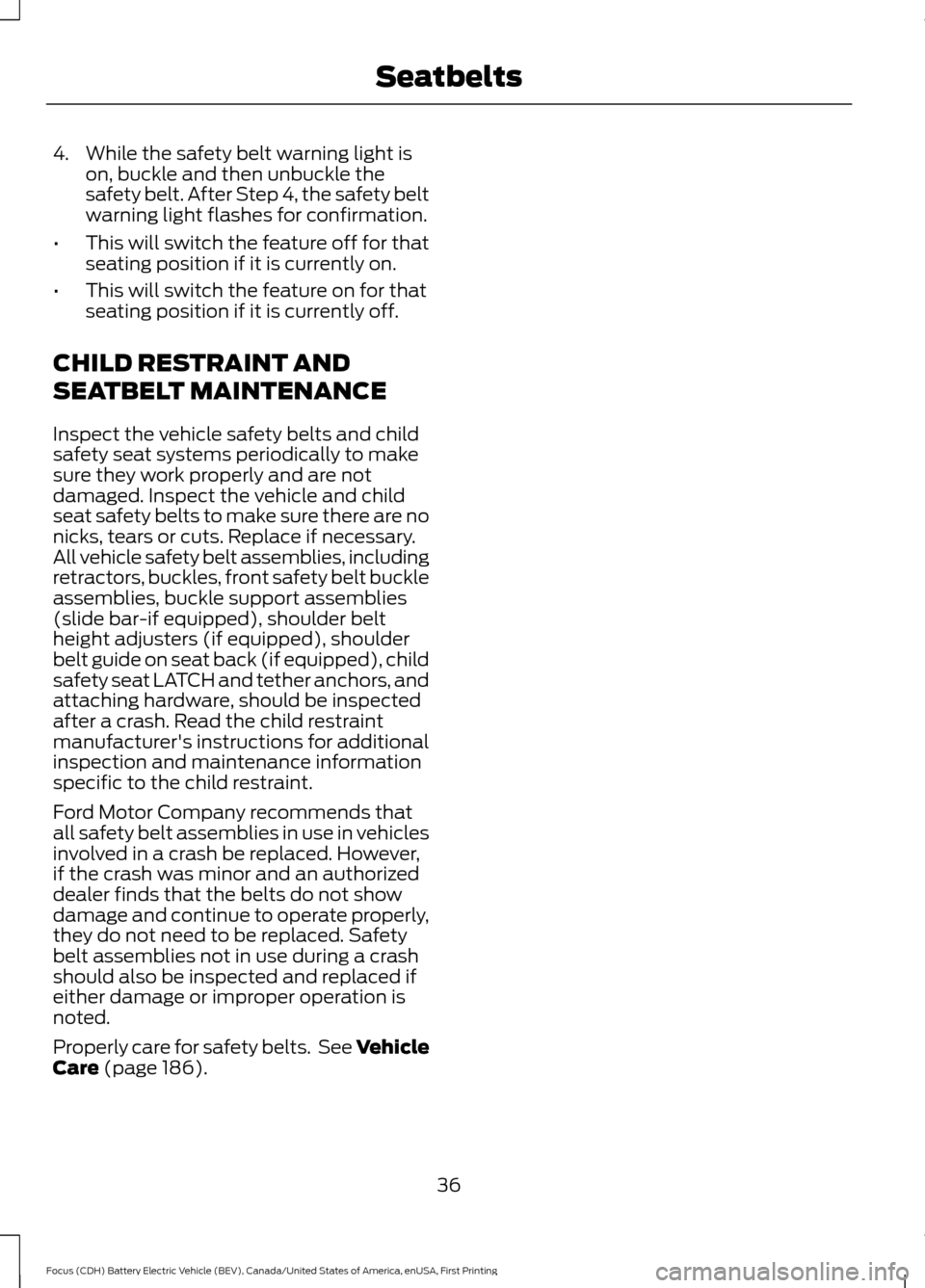
4. While the safety belt warning light is
on, buckle and then unbuckle the
safety belt. After Step 4, the safety belt
warning light flashes for confirmation.
• This will switch the feature off for that
seating position if it is currently on.
• This will switch the feature on for that
seating position if it is currently off.
CHILD RESTRAINT AND
SEATBELT MAINTENANCE
Inspect the vehicle safety belts and child
safety seat systems periodically to make
sure they work properly and are not
damaged. Inspect the vehicle and child
seat safety belts to make sure there are no
nicks, tears or cuts. Replace if necessary.
All vehicle safety belt assemblies, including
retractors, buckles, front safety belt buckle
assemblies, buckle support assemblies
(slide bar-if equipped), shoulder belt
height adjusters (if equipped), shoulder
belt guide on seat back (if equipped), child
safety seat LATCH and tether anchors, and
attaching hardware, should be inspected
after a crash. Read the child restraint
manufacturer's instructions for additional
inspection and maintenance information
specific to the child restraint.
Ford Motor Company recommends that
all safety belt assemblies in use in vehicles
involved in a crash be replaced. However,
if the crash was minor and an authorized
dealer finds that the belts do not show
damage and continue to operate properly,
they do not need to be replaced. Safety
belt assemblies not in use during a crash
should also be inspected and replaced if
either damage or improper operation is
noted.
Properly care for safety belts. See Vehicle
Care (page 186).
36
Focus (CDH) Battery Electric Vehicle (BEV), Canada/United States of America, enUSA, First Printing Seatbelts
Page 41 of 276
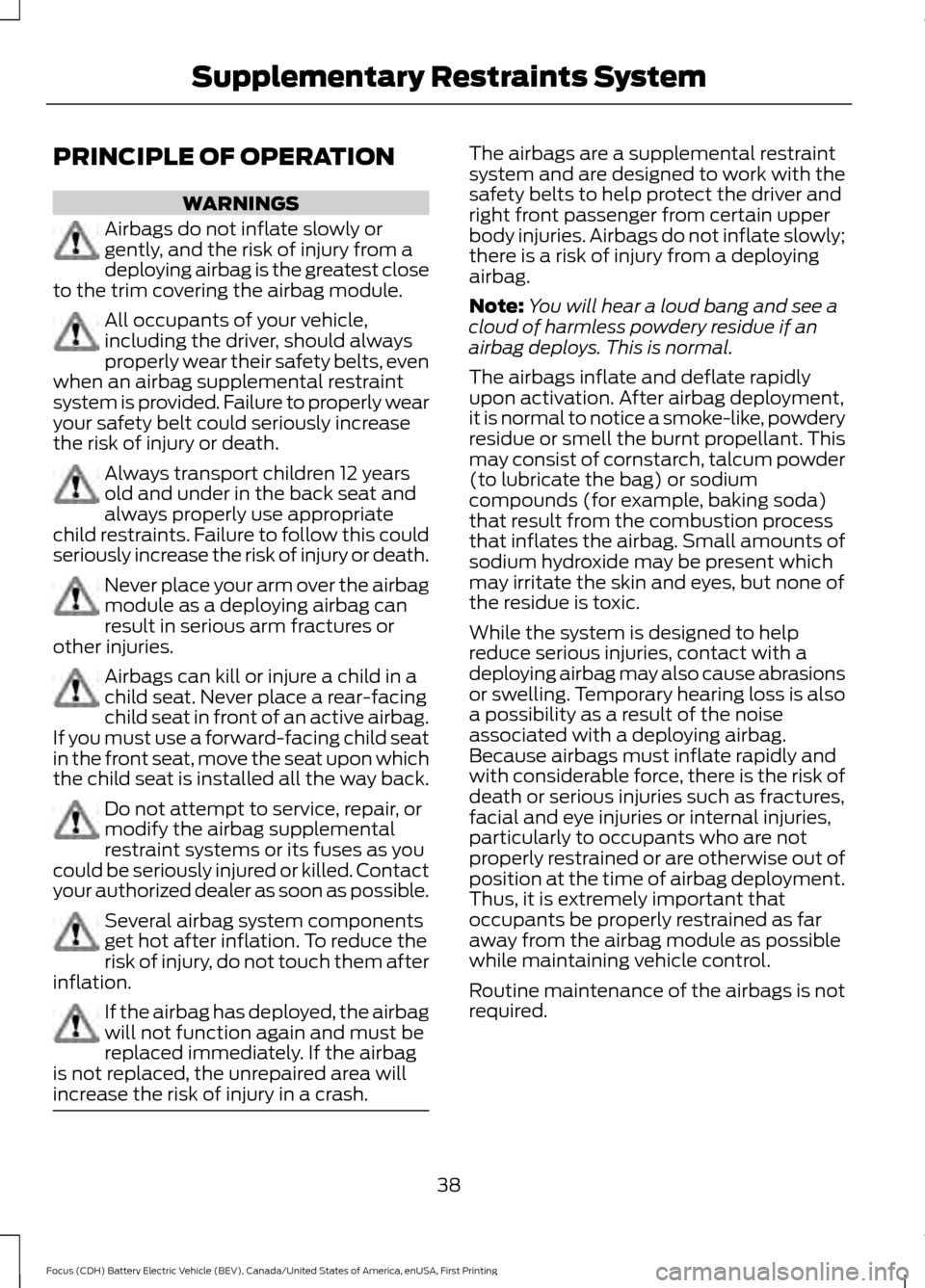
PRINCIPLE OF OPERATION
WARNINGS
Airbags do not inflate slowly or
gently, and the risk of injury from a
deploying airbag is the greatest close
to the trim covering the airbag module. All occupants of your vehicle,
including the driver, should always
properly wear their safety belts, even
when an airbag supplemental restraint
system is provided. Failure to properly wear
your safety belt could seriously increase
the risk of injury or death. Always transport children 12 years
old and under in the back seat and
always properly use appropriate
child restraints. Failure to follow this could
seriously increase the risk of injury or death. Never place your arm over the airbag
module as a deploying airbag can
result in serious arm fractures or
other injuries. Airbags can kill or injure a child in a
child seat. Never place a rear-facing
child seat in front of an active airbag.
If you must use a forward-facing child seat
in the front seat, move the seat upon which
the child seat is installed all the way back. Do not attempt to service, repair, or
modify the airbag supplemental
restraint systems or its fuses as you
could be seriously injured or killed. Contact
your authorized dealer as soon as possible. Several airbag system components
get hot after inflation. To reduce the
risk of injury, do not touch them after
inflation. If the airbag has deployed, the airbag
will not function again and must be
replaced immediately. If the airbag
is not replaced, the unrepaired area will
increase the risk of injury in a crash. The airbags are a supplemental restraint
system and are designed to work with the
safety belts to help protect the driver and
right front passenger from certain upper
body injuries. Airbags do not inflate slowly;
there is a risk of injury from a deploying
airbag.
Note:
You will hear a loud bang and see a
cloud of harmless powdery residue if an
airbag deploys. This is normal.
The airbags inflate and deflate rapidly
upon activation. After airbag deployment,
it is normal to notice a smoke-like, powdery
residue or smell the burnt propellant. This
may consist of cornstarch, talcum powder
(to lubricate the bag) or sodium
compounds (for example, baking soda)
that result from the combustion process
that inflates the airbag. Small amounts of
sodium hydroxide may be present which
may irritate the skin and eyes, but none of
the residue is toxic.
While the system is designed to help
reduce serious injuries, contact with a
deploying airbag may also cause abrasions
or swelling. Temporary hearing loss is also
a possibility as a result of the noise
associated with a deploying airbag.
Because airbags must inflate rapidly and
with considerable force, there is the risk of
death or serious injuries such as fractures,
facial and eye injuries or internal injuries,
particularly to occupants who are not
properly restrained or are otherwise out of
position at the time of airbag deployment.
Thus, it is extremely important that
occupants be properly restrained as far
away from the airbag module as possible
while maintaining vehicle control.
Routine maintenance of the airbags is not
required.
38
Focus (CDH) Battery Electric Vehicle (BEV), Canada/United States of America, enUSA, First Printing Supplementary Restraints System
Page 48 of 276
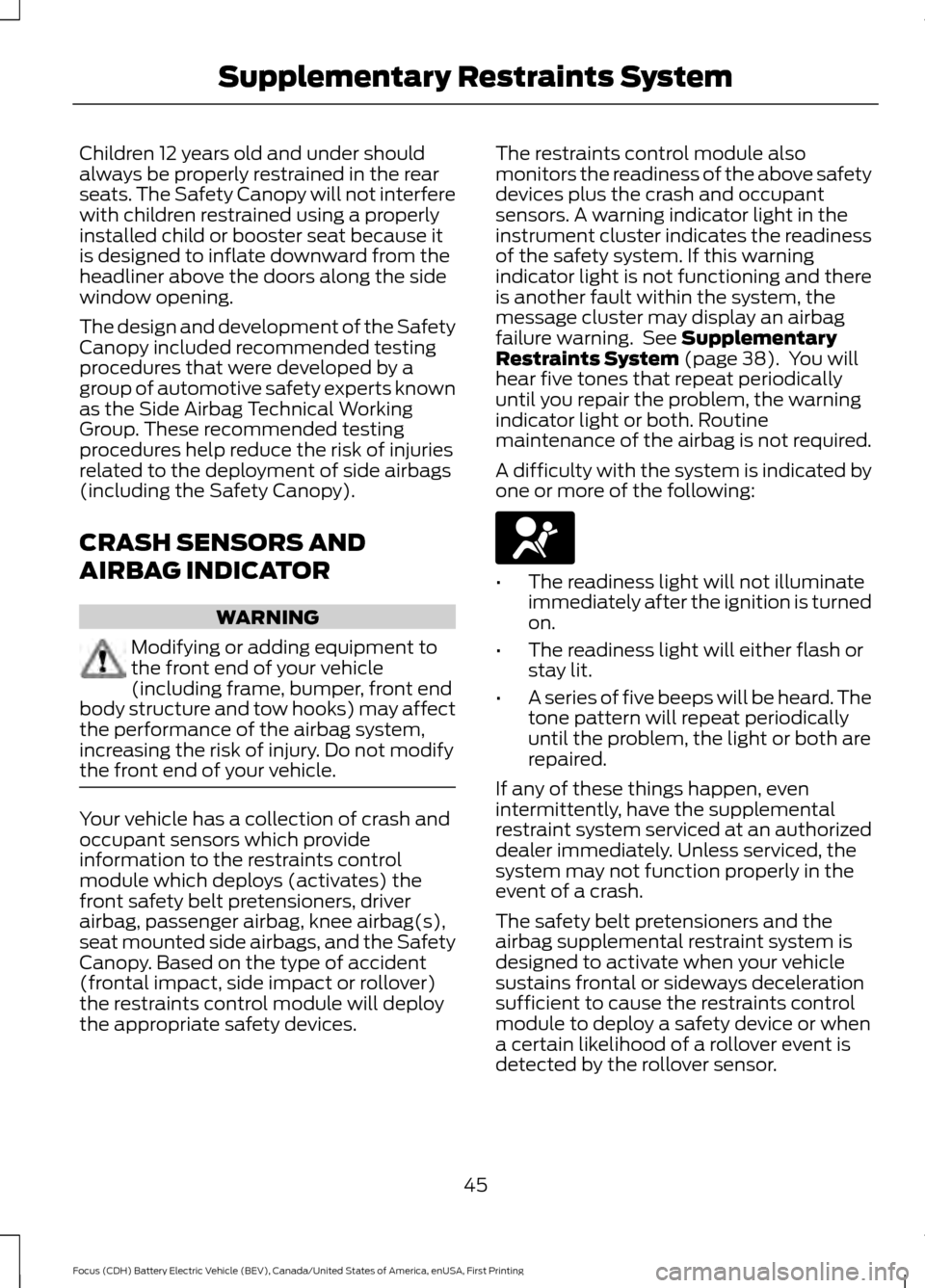
Children 12 years old and under should
always be properly restrained in the rear
seats. The Safety Canopy will not interfere
with children restrained using a properly
installed child or booster seat because it
is designed to inflate downward from the
headliner above the doors along the side
window opening.
The design and development of the Safety
Canopy included recommended testing
procedures that were developed by a
group of automotive safety experts known
as the Side Airbag Technical Working
Group. These recommended testing
procedures help reduce the risk of injuries
related to the deployment of side airbags
(including the Safety Canopy).
CRASH SENSORS AND
AIRBAG INDICATOR
WARNING
Modifying or adding equipment to
the front end of your vehicle
(including frame, bumper, front end
body structure and tow hooks) may affect
the performance of the airbag system,
increasing the risk of injury. Do not modify
the front end of your vehicle. Your vehicle has a collection of crash and
occupant sensors which provide
information to the restraints control
module which deploys (activates) the
front safety belt pretensioners, driver
airbag, passenger airbag, knee airbag(s),
seat mounted side airbags, and the Safety
Canopy. Based on the type of accident
(frontal impact, side impact or rollover)
the restraints control module will deploy
the appropriate safety devices. The restraints control module also
monitors the readiness of the above safety
devices plus the crash and occupant
sensors. A warning indicator light in the
instrument cluster indicates the readiness
of the safety system. If this warning
indicator light is not functioning and there
is another fault within the system, the
message cluster may display an airbag
failure warning. See Supplementary
Restraints System (page 38). You will
hear five tones that repeat periodically
until you repair the problem, the warning
indicator light or both. Routine
maintenance of the airbag is not required.
A difficulty with the system is indicated by
one or more of the following: •
The readiness light will not illuminate
immediately after the ignition is turned
on.
• The readiness light will either flash or
stay lit.
• A series of five beeps will be heard. The
tone pattern will repeat periodically
until the problem, the light or both are
repaired.
If any of these things happen, even
intermittently, have the supplemental
restraint system serviced at an authorized
dealer immediately. Unless serviced, the
system may not function properly in the
event of a crash.
The safety belt pretensioners and the
airbag supplemental restraint system is
designed to activate when your vehicle
sustains frontal or sideways deceleration
sufficient to cause the restraints control
module to deploy a safety device or when
a certain likelihood of a rollover event is
detected by the rollover sensor.
45
Focus (CDH) Battery Electric Vehicle (BEV), Canada/United States of America, enUSA, First Printing Supplementary Restraints System